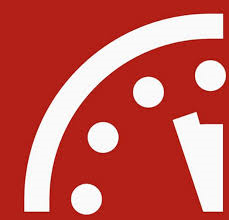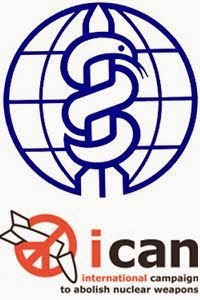That nations (led by the US and Israel) scream and shout about Iran while essentially ignoring the clear and present danger posed by the existence of so many nuclear weapons (by nations prepared to use them) in an increasingly tense, new Cold War that is brewing, is madness and is a crime against humanity.
Enter the calm, clear voice of the respected historian of the nuclear age and the movement to abolish nuclear weapons. Lawrence Wittner wrote the following article to offer an important perspective on the current nuclear conundrum, the Nuclear Non-Proliferation Treaty (NPT), and the Upcoming NPT Review Conference. The big question is, "What will it take to move the nuclear weapons states in a positive direction (towards disarmament)?"
In his book Confronting the Bomb, Wittner wrote that it is not the conventional explanation of "deterrence" that has saved the world from nuclear annihilation over the past 65 years, but a "massive nuclear disarmament movement." Let us hope that we will have a “massive” presence in New York City this April to send a clear message to the nuclear weapons states that the time for disarmament is NOW!
*********************
Who Are the Nuclear Scofflaws?
By Lawrence S. Wittner
Dr. Lawrence Wittner (http://lawrenceswittner.com) is Professor of History emeritus at SUNY/Albany. He is the author of "Confronting the Bomb: A Short History of the World Nuclear Disarmament Movement" (Stanford University Press).
 |
| Test launch of a Trident submarine-launched ballistic missile |
But it’s not. The NPT, signed by 190 nations and in effect since 1970, is a treaty in which the non-nuclear nations agreed to forgo developing nuclear weapons and the nuclear nations agreed to divest themselves of their nuclear weapons. It also granted nations the right to develop peaceful nuclear power. The current negotiations in which Iran is engaged with other nations are merely designed to guarantee that Iran, which signed the NPT, does not cross the line from developing nuclear power to developing nuclear weapons.
Nine nations, however, have flouted the NPT by either developing nuclear weapons since the treaty went into effect or failing to honor the commitment to disarm. These nine scofflaws and their nuclear arsenals are Russia (7,500 nuclear warheads), the United States (7,100 nuclear warheads), France (300 nuclear warheads), China (250 nuclear warheads), Britain (215 nuclear warheads), Pakistan (100-120 nuclear warheads), India (90-110 nuclear warheads), Israel (80 nuclear warheads), and North Korea (10 nuclear warheads).
Nor are the nuclear powers likely to be in compliance with the NPT any time soon. The Indian and Pakistani governments are engaged in a rapid nuclear weapons buildup, while the British government is contemplating the development of a new, more advanced nuclear weapons system. Although, in recent decades, the U.S. and Russian governments did reduce their nuclear arsenals substantially, that process has come to a halt in recent years, as relations have soured between the two nations. Indeed, both countries are currently engaged in a new, extremely dangerous nuclear arms race. The U.S. government has committed itself to spending $1 trillion to “modernize” its nuclear facilities and build new nuclear weapons. For its part, the Russian government is investing heavily in the upgrading of its nuclear warheads and the development of new delivery systems, such as nuclear missiles and nuclear submarines.
What can be done about this flouting of the NPT, some 45 years after it went into operation?
That will almost certainly be a major issue at an NPT Review Conference that will convene at the UN headquarters, in New York City, from April 27 to May 22. These review conferences, held every five years, attract high-level national officials from around the world to discuss the treaty’s implementation. For a very brief time, the review conferences even draw the attention of television and other news commentators before the mass communications media return to their preoccupation with scandals, arrests, and the lives of movie stars.
This spring’s NPT review conference might be particularly lively, given the heightening frustration of the non-nuclear powers at the failure of the nuclear powers to fulfill their NPT commitments. At recent disarmament conferences in Norway, Mexico and Austria, the representatives of a large number of non-nuclear nations, ignoring the opposition of the nuclear powers, focused on the catastrophic humanitarian consequences of nuclear war. One rising demand among restless non-nuclear nations and among nuclear disarmament groups is to develop a nuclear weapons ban treaty, whether or not the nuclear powers are willing to participate in negotiations.
To heighten the pressure for the abolition of nuclear weapons, nuclear disarmament groups are staging a Peace and Planet mobilization, in Manhattan, on the eve of the NPT review conference. Calling for a “Nuclear-Free, Peaceful, Just, and Sustainable World,” the mobilization involves an international conference (comprised of plenaries and workshops) on April 24 and 25, plus a culminating interfaith convocation, rally, march, and festival on April 26. Among the hundreds of endorsing organizations are many devoted to peace (Fellowship of Reconciliation, Pax Christi, Peace Action, Physicians for Social Responsibility, Veterans for Peace, and Women’s International League for Peace & Freedom), environmentalism (Earth Action, Friends of the Earth, and 350NYC), religion (Maryknoll Office for Global Concerns, Unitarian Universalist UN Office, United Church of Christ, and United Methodist General Board of Church & Society), workers’ rights (New Jersey Industrial Union Council, United Electrical Workers, and Working Families Party), and human welfare (American Friends Service Committee and National Association of Social Workers).
Of course, how much effect the proponents of a nuclear weapons-free world will have on the cynical officials of the nuclear powers remains to be seen. After as many as 45 years of stalling on their own nuclear disarmament, it is hard to imagine that they are finally ready to begin negotiating a treaty effectively banning nuclear weapons―or at least their nuclear weapons.
Meanwhile, let us encourage Iran not to follow the bad example set by the nuclear powers. And let us ask the nuclear-armed nations, now telling Iran that it should forgo the possession of nuclear weapons, when they are going to start practicing what they preach.
Originally published in History News Network, original source URL: http://historynewsnetwork.org/article/158896












No comments:
Post a Comment